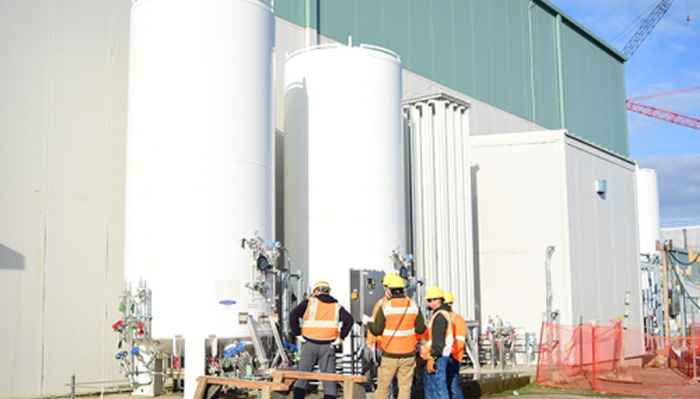Product Category
Details of designing liquid argon storage tanks
Date: Feb 26, 2020

With the rapid development of cryogenic cryogenic technology, the use of liquid argon storage tanks in medical, energy and other industries is also increasing. As a common equipment for storing cryogenic liquids such as liquid argon, the design of liquid argon storage tanks is similar to ordinary pressure vessel equipment, but there are many differences, so the design requirements are often higher. The following takes a 15m3 cryogenic liquid argon storage tank as an example to briefly explain some issues that should be noticed in the calculation of the basic structure of the storage tank, the design of the pipeline, and the calculation of the heat leakage.
1. Design and calculation of basic structure of liquid hydrogen storage tank
The liquid argon storage tank adopts a jacket structure. The inner tank of the liquid argon storage tank is filled with low temperature cryogenic liquid. For the inner tank, we use low temperature resistant austenitic stainless steel. For the jacketed container, the interlayer is vacuum. When calculating GB150, not only the influence of the internal pressure of the equipment's inner tank and the calculation and value of the pressure test according to GB184423-2011, but also the effect of the external pressure instability caused by the vacuum on the inner tank and the shell should be considered. In the calculation, we use the calculation method of pressure vessel design in GB150.2-2011. The external pressure instability is a common method for pressure vessel design. It can save the material and reduce the weight. The tank and the barrel of the casing are not unstable, thereby ensuring the normal use of the device. For the convenience of production, the method of using the inner reinforcing ring on the inner tank to enhance the thermal insulation effect is also a method commonly used in the production of storage tanks. 2.Piping design of liquid argon storage tank
2.Piping design of liquid argon storage tank
Because the 15m3 liquid argon storage tank contains cryogenic medium, first of all, when designing the relevant pipelines, we should consider the impact of thermal expansion and contraction caused by low temperature on the equipment pipeline. Because the 15m3 liquid chlorine storage tank is a vertical cryogenic storage tank For the installation of the tank, the pipeline valve is usually arranged at the lower part of the outer bottom head of the storage tank. After the tube is taken out, it needs to be led out of the shell through a vacuum powder insulation layer. When the cryogenic liquid in the storage tank is discharged, the gas phase space in the storage tank increases, and the pressure in the storage tank will gradually decrease. We should increase the pressure in the storage tank. For the pressurization in the cryogenic storage tank, we can use a cryopump to boost the pressure, or use a booster carburetor to self-pressurize. Self-pressurized carburetor mostly adopts finned tube structure. Self-pressurized carburetor is mostly used as a part of the liquid argon storage tank pipeline. At this time, in addition to considering the arrangement of the self-pressurizer at the bottom of the tank, we should also follow CB18442.3. -2011 Consider and calculate the relevant design of the self-pressurized carburetor's vaporization capacity, material and medium compatibility, pressure level and inner container design pressure.
3. Calculation of Heat Leakage of Liquid Argon Cryogenic Tank
Due to the temperature difference between the low temperature cryogenic medium in the liquid argon storage tank and the environment, heat leakage is inevitable. Controlling heat leakage during design can ensure effective and safe operation of the equipment. Therefore, in the design we should carry out the thermal calculation of heat leakage. The calculation of heat leakage is also a common feature of low-temperature storage tank design. The calculation of heat leakage for a 15m3 liquid argon storage tank should include the calculation of heat leakage in the insulation layer, the calculation of heat leakage in the support liner, and the calculation of heat leakage in the circumferential support. The calculation of the leakage heat of the pipeline part, etc. From the total leakage heat, we can calculate the corresponding static evaporation rate. According to the requirements of GB184423-2011, the static evaporation rate of the 15m liquid argon cryogenic storage tank should meet ≤ 0.37% kg / d.
1. Design and calculation of basic structure of liquid hydrogen storage tank
The liquid argon storage tank adopts a jacket structure. The inner tank of the liquid argon storage tank is filled with low temperature cryogenic liquid. For the inner tank, we use low temperature resistant austenitic stainless steel. For the jacketed container, the interlayer is vacuum. When calculating GB150, not only the influence of the internal pressure of the equipment's inner tank and the calculation and value of the pressure test according to GB184423-2011, but also the effect of the external pressure instability caused by the vacuum on the inner tank and the shell should be considered. In the calculation, we use the calculation method of pressure vessel design in GB150.2-2011. The external pressure instability is a common method for pressure vessel design. It can save the material and reduce the weight. The tank and the barrel of the casing are not unstable, thereby ensuring the normal use of the device. For the convenience of production, the method of using the inner reinforcing ring on the inner tank to enhance the thermal insulation effect is also a method commonly used in the production of storage tanks.

Because the 15m3 liquid argon storage tank contains cryogenic medium, first of all, when designing the relevant pipelines, we should consider the impact of thermal expansion and contraction caused by low temperature on the equipment pipeline. Because the 15m3 liquid chlorine storage tank is a vertical cryogenic storage tank For the installation of the tank, the pipeline valve is usually arranged at the lower part of the outer bottom head of the storage tank. After the tube is taken out, it needs to be led out of the shell through a vacuum powder insulation layer. When the cryogenic liquid in the storage tank is discharged, the gas phase space in the storage tank increases, and the pressure in the storage tank will gradually decrease. We should increase the pressure in the storage tank. For the pressurization in the cryogenic storage tank, we can use a cryopump to boost the pressure, or use a booster carburetor to self-pressurize. Self-pressurized carburetor mostly adopts finned tube structure. Self-pressurized carburetor is mostly used as a part of the liquid argon storage tank pipeline. At this time, in addition to considering the arrangement of the self-pressurizer at the bottom of the tank, we should also follow CB18442.3. -2011 Consider and calculate the relevant design of the self-pressurized carburetor's vaporization capacity, material and medium compatibility, pressure level and inner container design pressure.
3. Calculation of Heat Leakage of Liquid Argon Cryogenic Tank
Due to the temperature difference between the low temperature cryogenic medium in the liquid argon storage tank and the environment, heat leakage is inevitable. Controlling heat leakage during design can ensure effective and safe operation of the equipment. Therefore, in the design we should carry out the thermal calculation of heat leakage. The calculation of heat leakage is also a common feature of low-temperature storage tank design. The calculation of heat leakage for a 15m3 liquid argon storage tank should include the calculation of heat leakage in the insulation layer, the calculation of heat leakage in the support liner, and the calculation of heat leakage in the circumferential support. The calculation of the leakage heat of the pipeline part, etc. From the total leakage heat, we can calculate the corresponding static evaporation rate. According to the requirements of GB184423-2011, the static evaporation rate of the 15m liquid argon cryogenic storage tank should meet ≤ 0.37% kg / d.
Send Your Inquiry
We not only provide a good product, but also provide high quality service. If you are interested in our products,
you can contact us in the following ways.
you can contact us in the following ways.







